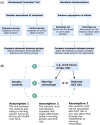Neuropsychiatric disorders, chronotype and sleep: A narrative review of GWAS findings and the application of Mendelian randomization to investigate causal relationships
- PMID: 38359178
- PMCID: PMC10869127
- DOI: 10.1111/gbb.12885
Neuropsychiatric disorders, chronotype and sleep: A narrative review of GWAS findings and the application of Mendelian randomization to investigate causal relationships
Abstract
Genome-wide association studies (GWAS) have been important for characterizing the genetic component and enhancing our understanding of the biological aetiology of both neuropsychiatric disorders and sleep-related phenotypes such as chronotype, which is our preference for morning or evening time. Mendelian randomization (MR) is a post-GWAS analysis that is used to infer causal relationships between potential risk factors and outcomes. MR uses genetic variants as instrumental variants for exposures to study the effect on outcomes. This review details the main results from GWAS of neuropsychiatric disorders and sleep-related phenotypes, and the application of MR to investigate their bidirectional relationship. The main results from MR studies of neuropsychiatric disorders and sleep-related phenotypes are summarized. These MR studies have identified 37 causal relationships between neuropsychiatric disorders and sleep-related phenotypes. MR studies identified evidence of a causal role for five neuropsychiatric disorders and symptoms (attention deficit hyperactivity disorder, bipolar disorder, depressive symptoms, major depressive disorder and schizophrenia) on sleep-related phenotypes and evidence of a causal role for five sleep-related phenotypes (daytime napping, insomnia, morning person, long sleep duration and sleep duration) on risk for neuropsychiatric disorders. These MR results show a bidirectional relationship between neuropsychiatric disorders and sleep-related phenotypes and identify potential risk factors for follow-up studies.
Keywords: Mendelian randomization; chronotype; genome-wide association studies; neuropsychiatric disorders; sleep.
© 2024 The Authors. Genes, Brain and Behavior published by International Behavioural and Neural Genetics Society and John Wiley & Sons Ltd.
Figures



Similar articles
-
Mendelian randomization analysis using GWAS and eQTL data to investigate the relationship between chronotype and neuropsychiatric disorders and their molecular basis.Am J Med Genet B Neuropsychiatr Genet. 2024 Oct;195(7):e32980. doi: 10.1002/ajmg.b.32980. Epub 2024 Mar 29. Am J Med Genet B Neuropsychiatr Genet. 2024. PMID: 38549512
-
Evaluating causal associations of chronotype with pregnancy and perinatal outcomes and its interactions with insomnia and sleep duration: a mendelian randomization study.BMC Pregnancy Childbirth. 2024 Dec 18;24(1):816. doi: 10.1186/s12884-024-07023-8. BMC Pregnancy Childbirth. 2024. PMID: 39696061 Free PMC article.
-
No bidirectional relationship between sleep phenotypes and risk of proliferative diabetic retinopathy: a two-sample Mendelian randomization study.Sci Rep. 2024 Apr 26;14(1):9585. doi: 10.1038/s41598-024-60446-3. Sci Rep. 2024. PMID: 38671284 Free PMC article.
-
Associations between sleep traits and colorectal cancer: a mendelian randomization analysis.Front Oncol. 2025 Feb 6;15:1416243. doi: 10.3389/fonc.2025.1416243. eCollection 2025. Front Oncol. 2025. PMID: 39980544 Free PMC article.
-
Leveraging genetic discoveries for sleep to determine causal relationships with common complex traits.Sleep. 2022 Oct 10;45(10):zsac180. doi: 10.1093/sleep/zsac180. Sleep. 2022. PMID: 35908176 Free PMC article. Review.
Cited by
-
Sleep inertia drives the association of evening chronotype with psychiatric disorders: epidemiological and genetic evidence.medRxiv [Preprint]. 2024 Sep 11:2024.09.10.24313197. doi: 10.1101/2024.09.10.24313197. medRxiv. 2024. PMID: 39314956 Free PMC article. Preprint.
-
Clinical efficacy of meridian differentiation acupuncture in the treatment of intractable insomnia based on objective data: a protocol for a multicentre, single-blind, randomised controlled trial.BMJ Open. 2025 Jul 24;15(7):e095833. doi: 10.1136/bmjopen-2024-095833. BMJ Open. 2025. PMID: 40707148 Free PMC article.
-
Causal effects of schizophrenia on sleep and eating disorders: A Mendelian randomization study.Medicine (Baltimore). 2025 May 2;104(18):e42334. doi: 10.1097/MD.0000000000042334. Medicine (Baltimore). 2025. PMID: 40324258 Free PMC article.
-
Polygenic risk scores for mood disorders and actigraphy estimates of sleep and circadian rhythms: A preliminary study in bipolar disorders.J Sleep Res. 2025 Feb;34(1):e14307. doi: 10.1111/jsr.14307. Epub 2024 Aug 21. J Sleep Res. 2025. PMID: 39168480 Free PMC article.
References
-
- Pitkanen MLS, Stevens T, Kopelman MD. Neuropsychiatric disorders. In: Warrell DA, Cox TM, Firth JD, eds. Oxford Textbook of Medicine. 5th ed. Oxford Textbooks; 2010. 10.1093/med/9780199204854.003.2604 - DOI
-
- Jawabri KH, Raja A. Physiology, sleep patterns. StatPearls. StatPearls Publishing; 2022. - PubMed
Publication types
MeSH terms
Grants and funding
LinkOut - more resources
Full Text Sources

